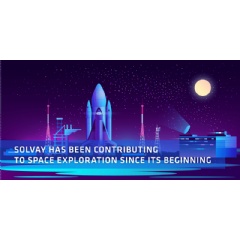Solvay materials have been traveling to outer space for 50 years!
From space suits to spaceships, Solvay composites and specialty polymers are out of this world
Solvay has had a very early involvement in the space market, offering the broadest portfolio of product options dedicated to space applications, coupled with the most comprehensive material performance database in the industry. -Don Wantock, Product Portfolio Manager at Solvay’s Composite Materials business unit.
On the occasion of the 50th anniversary of humankind’s first step on the Moon, we take a look at the various Solvay materials that have been contributing to space exploration ever since there has been such a thing as space exploration!
Did you know Solvay materials were on board the Apollo 11 mission that sent humans to the Moon for the first time? The Group’s Udel® polysulfone (PSU) polymer was developed in 1965, just in time to be used to make the visors on Buzz Aldrin and Neil Armstrong’s space suits as they set foot on the Moon in July 1969. Udel® PSU was the material of choice thanks to it being a tough and transparent plastic that can resist extremely high temperatures. Today it’s widely used on Earth too, for diverse applications in markets such as healthcare, water, electronics, consumer goods, and construction.
But Solvay’s escapades with space exploration go back even further than that... in the 1950s, scientists working on the very first space programs were looking for materials capable of withstanding the incredibly high temperatures produced by rocket engines and re-entry into the Earth’s atmosphere. Their search led them to identify certain materials used in the welding industry produced by, you guessed it: Solvay.
Charred and protectedThese materials called ablatives are capable of withstanding, at least for periods of several minutes, temperatures reaching 2700°C. How? By forming a char layer on their surface: the superficial “crust” created is a structural carbon, thereby protecting and insulating the material behind it. An additional advantage of these ablative materials is “controlled erosion”, meaning that the charred proportion of material can be precisely estimated for a given amount of time, so one can predict how thick a layer of material is necessary. “Simply put, ablatives are used for places where it’s extraordinarily hot,” sums up Don Wantock, Product Portfolio Manager at Solvay’s Composite Materials business unit, ”most commonly the exit nozzle, where the exhaust is expelled out of the rocket engine”.
Through the decades, Solvay ablatives have been used in many space programs – Gemini, Saturn and Apollo to name a few. They were even present in the lunar module that safely landed Neil Armstrong and his fellow astronauts on the moon in 1969, in the rocket engine that slowed it down before it landed. From the 1970s to 2011, Solvay supported the NASA Space Shuttle, a major application of ablative materials as it required 14,500 kg of ablatives for each launch. These days, space programs such as Atlas V, Delta IV, Pegasus and Vega, as well as new launch vehicle programs, in development, use Solvay ablatives for their launch vehicles.
In space as in the skyBut it’s not all just ablatives. Other Solvay composites are used by the space industry, for example to manufacture the protective shroud covering the satellite during launch (“payload fairing”), as well as for structural elements in the satellites themselves. “A satellite is packed full of electronics, but the structure that holds all those electronics, the bus, is made of composite materials that Solvay provides,” explains Don. “We also provide composites for solar arrays, antennas and a few other uses.”
In the case of these structural elements, and just like in the aerospace industries, lightweighting is a crucial element. “For space applications, weight is especially critical because every additional kilo costs about $10,000 to launch into Earth orbit,” explains Don. “The composites used in space structural applications, which are frequently polymers like epoxy combined with a carbon fiber reinforcement, often exhibit special characteristics for space use, but they do have a resemblance to the materials employed for aircraft manufacturing.”
Finally, besides composites, one other category of Solvay products plays a critical albeit unexpected part in space programs: lubricants. Solvay’s Fomblin® PFPE has been the go-to lubrication solution for space vehicles built by both American and European agencies for the past 25 years, including NASA’s 1997 Mars Pathfinder and its famous Sojourner® Rover, for which a grease using Solvay’s lubricant was specially formulated.
Upward and OnwardSolvay Group remains a leading provider of composites for the space industry. There are several reasons for this, as Don says: “As a pioneer in composites, Solvay has had a very early involvement in the space market, offers the broadest portfolio of product options dedicated to space applications, coupled with the most comprehensive material performance database in the industry. We are engaged in bringing our composite and structural adhesive materials expertise to bear on the performance problems being worked today and welcome working the challenges involved with the next generation of space vehicles.”
Whatever the future of space exploration brings, Solvay plans to be a part of it.
( Press Release Image: https://photos.webwire.com/prmedia/6/244181/244181-1.gif )
WebWireID244181
This news content was configured by WebWire editorial staff. Linking is permitted.
News Release Distribution and Press Release Distribution Services Provided by WebWire.
